8 minute read

Table of Contents
Electric Wizards of Menlo Park
Aside: “The Coin”
I mention this game first because this is the project that earned me “The Coin”, an accolade (and actual coin) given by Prof. Boyan Radakovich that is highly coveted by students of game design.
With only 3 given out in my cohort of over 100, it is also coveted because of what Prof. Radakovich promises to do in return if you choose to “spend” it. Typically, folks spend it on a personal letter of recommendation, but it could be any favor ranging from waiving the final project in any of his classes, to coming out to help with a flat tire at 3am.
I have yet to spend my coin…
Prompt
Given the theme “Mad Scientist”, make a 2-player boardgame with engaging combat and relatively short playtime (20-40 minutes).
- 3 weeks to develop.
- 7 rounds of playtesting and iteration.
Introducing: “Electric Wizards of Menlo Park”

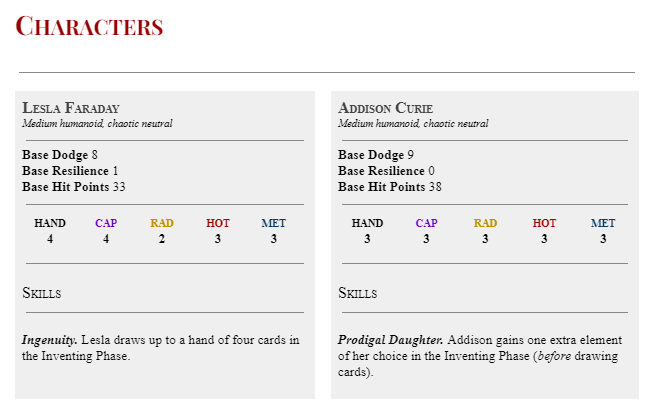
Rulebook & Materials
- Electric Wizards of Menlo Park Rulebook
- Cards (Printable, A4 or 8.5x11 inch paper)
- Player “Lab” Sheets (Printable, A3 or 11x17 inch paper)
Design Defense
Preview:
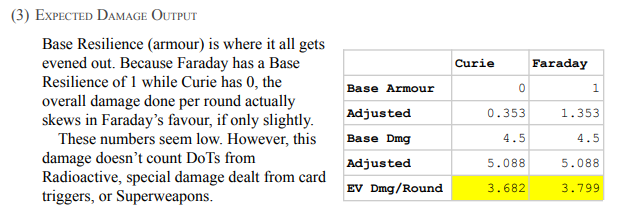
Lesson: Balance is less important than agency.
Balance is a calculation, a feeling, and a force all at the same time. At another time, it’s none of these things.
Balance is what metaphysicists might call a hyperobject.
As the designer of Electric Wizards, it fell upon me to mathematically figure how all the systems at play come together to calculate this “balance”. Truth is, I didn’t prove out this grand calculus to such extrema—and I don’t believe such a calculation should exist, either. A game of coin flip is a perfectly balanced 2-player game; but is it engaging? Challenging? Fun? More importantly, does knowing that flipping a coin is perfectly balanced actually improve players’ feelings towards the game?
A: No, no, no, and no.
I learned here that balance tastes better as an unanswerable question, and spiced with the feeling of being able to do something to improve your odds in spite of it. Of course, this doesn’t excuse the designer from using EV calculations, calculus, a minor in stats, blah blah blah to achieve their design goals; but, if I can use a spreadsheet to turn my game into a mathematically solved space in harmonious balance, I may as well hand my players a flipping coin and walk away.
I believe this is why so many games employ entropy (random elements) to “hide” balance issues. It can be done well, not enough, or—most often—way too much. That’s a whole other thread of discussions, though…
It is better to have a “maybe balanced?” system and focus more on player agency, than it is to seek “perfect balance”.
“Perfect balance” is probably only achievable in your game if you sacrifice player agency. (Don’t do that.)
Making a “maybe balanced?” system is no walk in the park, though—and yes, the designer still has to do lots of math, playtesting, and iteration.
Loot

Due to Loot being ported to a digital format in 2019, it has its own project page.
Lesson: Generate complexity from simplicity.
Think of chess. Chess was a wargame (originally). It’s an 8x8 grid with 6 types of pieces, each type having specific rules for movement and attacking, and all 32 pieces arranged symmetrically at the start. Players must take turns, there is no fog of war, and there are no random elements outside of opponent choice.
Chess is a gross oversimplification / misrepresentation of any battlefield in history, yet it is still effective at representing the abstract concept of tactical strategy, and it feels tactical through its emergent complexity—and this is why it is timeless.
Chess generates complexity from simple interlocking mechanics, player choices, and time.
In developing Loot, my primary goal was to accomplish a very similar dynamic. My mechanics might be simpler by comparison, but this was a necessary starting point in order to feel around for the knobs that would allow me to tune the game (in under 3 weeks).
I really wonder what a “grandmaster” match in Loot would look like… Could it even be a thing? 🤔
Eternal Valley
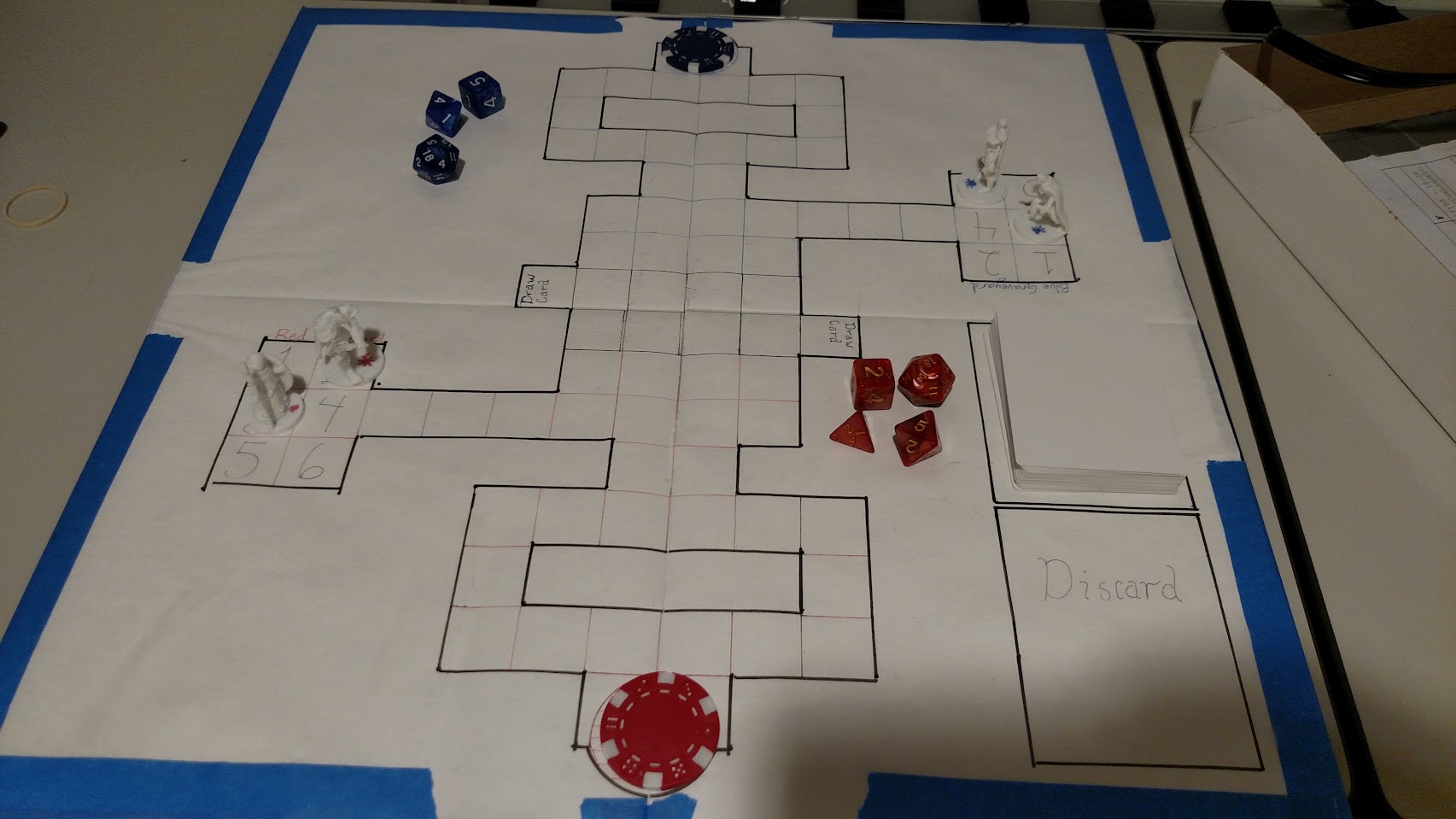
A capture-the-flag battleground for 4 players.
This was the very first boardgame I developed as part of my game design coursework at DigiPen, and I daresay it has withstood the test of time: we still play it at family game nights (and by no suggestion of mine).
The game is relatively easy to grasp; there are two teams, two flags, two spawn zones, and two “draw card” tiles. The mechanics can be summarized as
- “capture the flag” +
- simple dice-based movement and combat +
- special abilities (cards).
Rulebook & Cards
- Eternal Valley Rulebook
- No printable cards, because I hand-made the original sets. I’ll list them below instead.
| Name | Quantity | Effect Text |
|---|---|---|
| Sprint | 5 | Add an extra 1d4 to your movement roll. |
| Armour | 5 | Subtract 1d4 from the next attack made against you. |
| Bad Luck | 4 | This card does nothing. You may discard it. |
| Crossbow | 4 | Attack one enemy in a line within 3 tiles of you. Can be played as a response. |
| Inspiration | 4 | Add an extra 1d4 to your attack roll. |
| Mortal Blow | 2 | Add an extra 1d6 to your attack roll. |
| Second Wind | 2 | Add an extra 1d6 to your movement roll. |
| Blink | 2 | Move 1d6 tiles away when an enemy tries to attack you. Play before the attack roll. |
| Dodge | 2 | The next attack against you is ineffective. Play before the attack roll. |
| Frostbolt | 2 | Choose one enemy within 4 tiles of you. They skip their next turn, or halt an attack. Can be played as a response. |
| Fireball | 2 | Attack one enemy within 4 tiles of you. Add 2 to your attack roll. Can be played as a response. |
| Backstab | 2 | If you are behind an enemy, instantly kill them. |
Lesson: When recombining classic game elements, inject more uncertainty.
Familiar elements like capture-the-flag, rolling dice to move on a tile grid, and fireball spells are typically awesome building blocks to use in new games. I’ve seen many young designers shy away from using classic elements, because they don’t feel “unique” enough; to them, I’d say everything in existence is already unique, so you should instead be concerned about recombination done well versus done poorly.
Uncertainty was the user experience I focused on in my design of Eternal Valley, and I believe its the core of what made the experience feel fresh. Not knowing what kinds of cards the enemy hides in their hand, not knowing if you can make a certain dice roll, not knowing what kinds of cards might be in the deck—these are the primary moments of uncertainty that I honed in order to drum up a rhythm of engagement slopes, crested by more certain moments, such as using an ability card, picking up a flag, etc.
Indeed, uncertainty plays a pivotal role in all well-designed games… So why do I think it is important to consider uncertainty specifically when dealing with recombining “classic” game elements?
To answer concisely, it’s because when players are already familiar with the building blocks of a game, those blocks aren’t going to feel “new” to them (regardless if they actually know how they work); this tastes like certainty.
I call this “precipitating certainty”, and it has measurable impacts on engagement curves, as well as how a designer considers things like hidden information and tutorialization.
As a rule of thumb, the more precipitating certainty potentially in your game, the more un-certainty you should try developing at regular intervals.
Padana
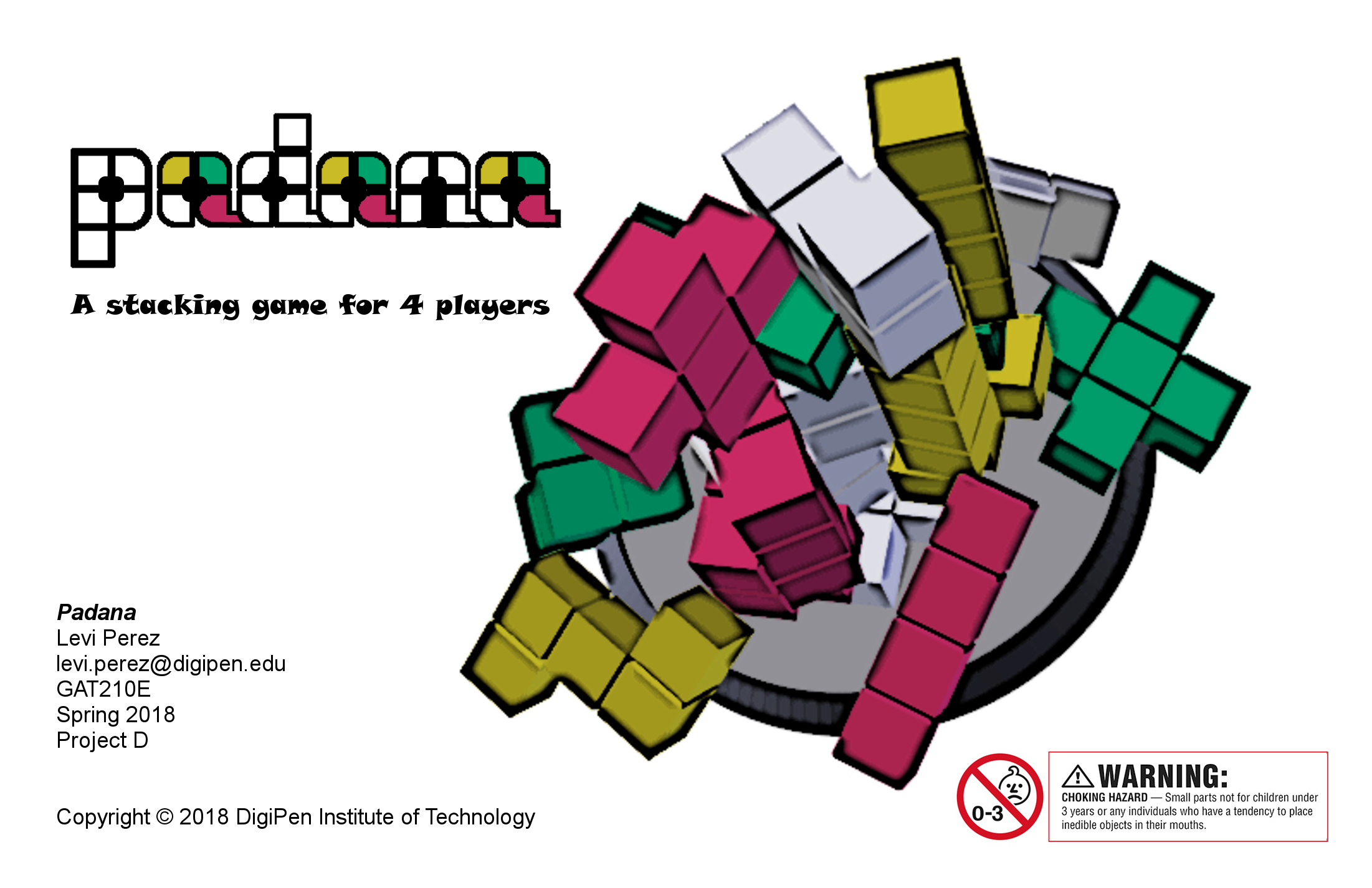
Prompt
Make a family-focused boardgame that encourages targeted actions and a variable per-game intensity curve.
- 3 weeks to develop.
- 9 rounds of playtesting and iteration.
Rules
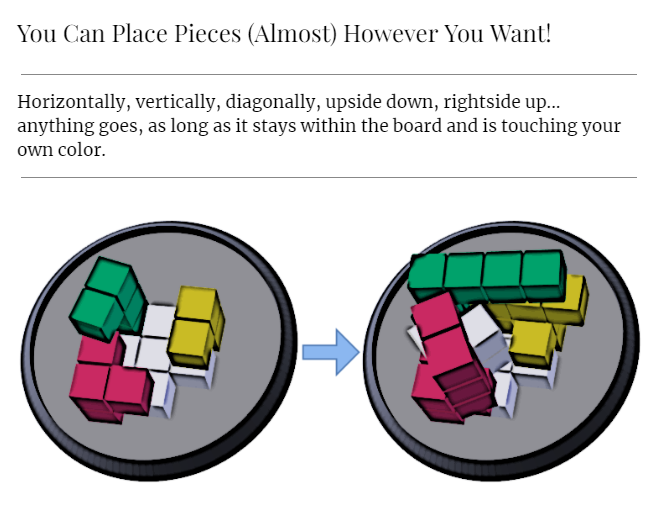
Summary: There is a deck of 44 cards. Players must draw and play cards in order to place specific 3D pieces. The game is over when the deck runs out, and the player with the highest piece on the board wins.
Padana has the targeted action of Blokus and the variable intensity curve of Jenga. (Calling it the daughter of both is probably accurate.)
Gallery
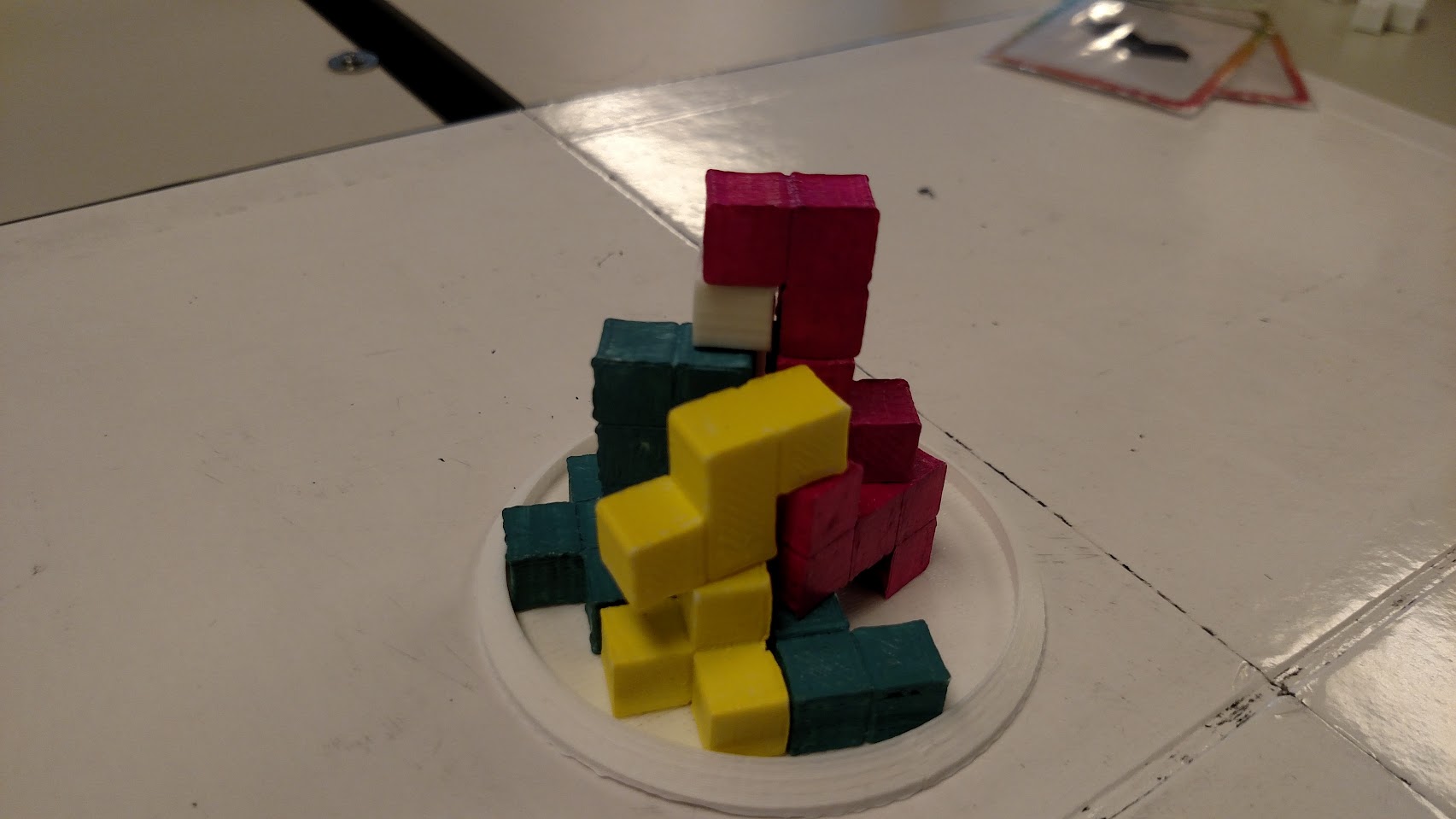
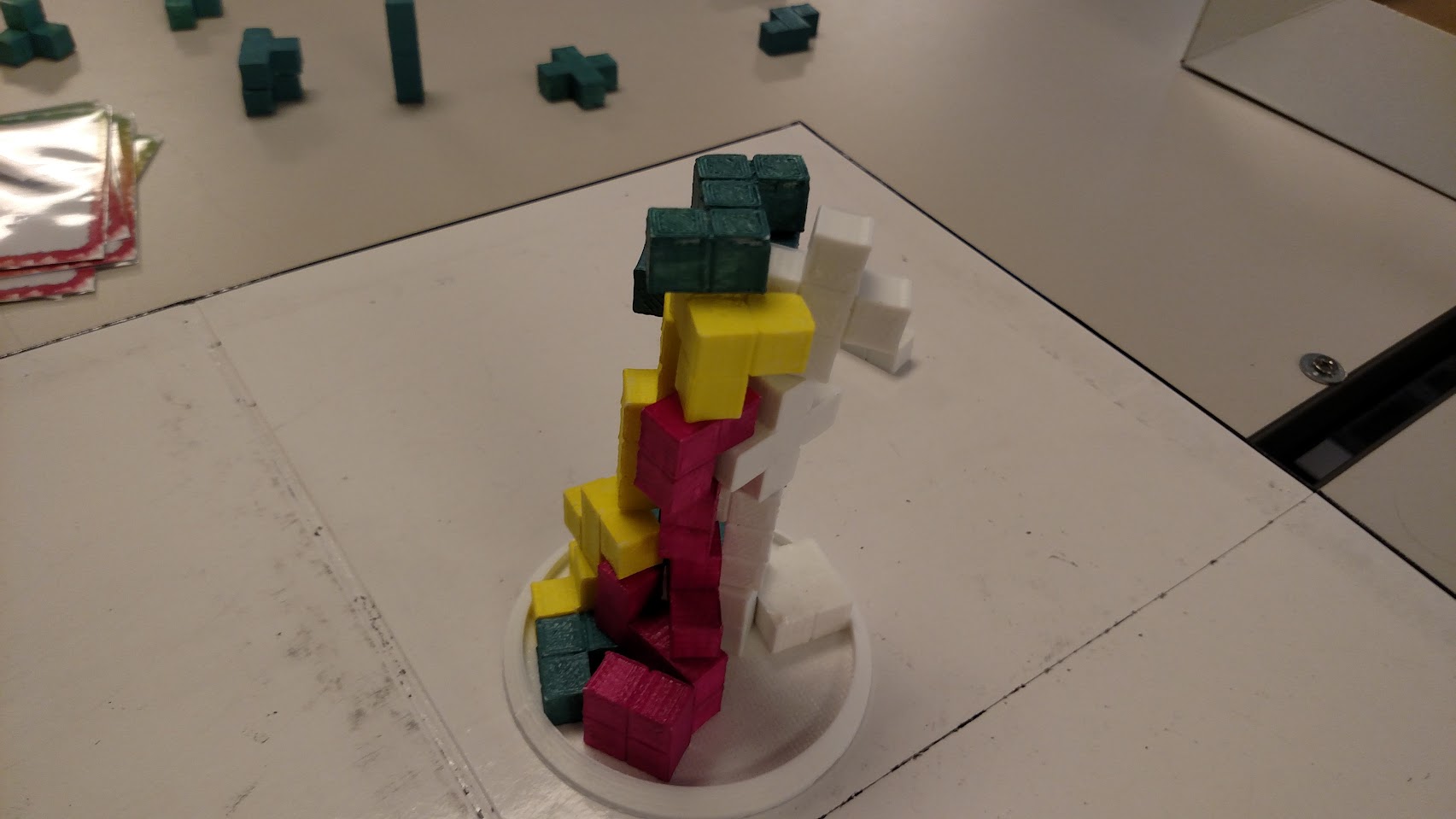
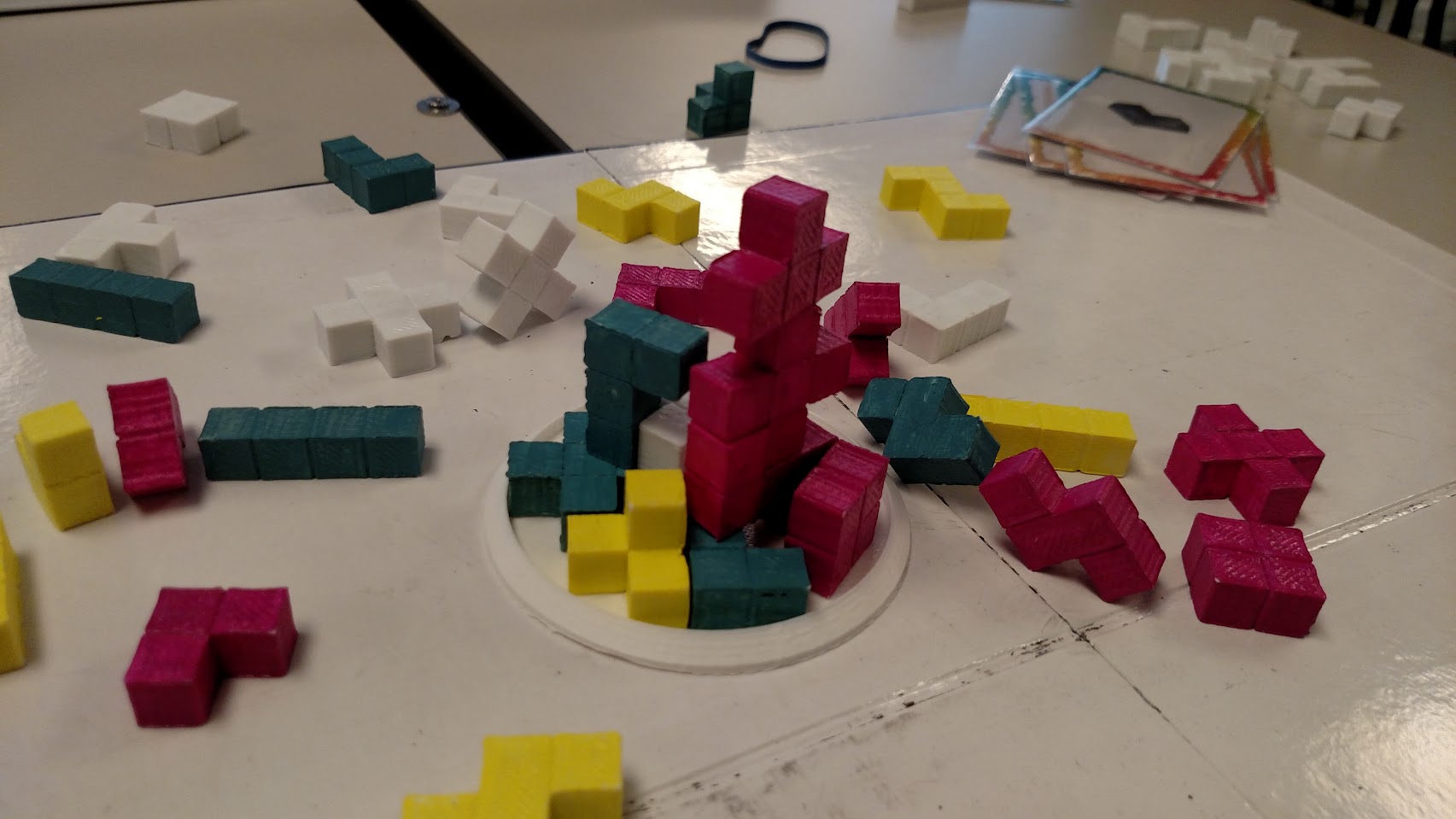
Lesson: Solve spatial problems with spatial solutions.
One of the most interesting design changes I made to Padana was switching the base board from a square shape to a circle. This simple physical difference in the play space had cascading impacts in how players approached the game, and overall was an incredibly elegant solution to a whole slough of problems.
Specifically, players on the square board would overwhelmingly begin playing the game by filling out an even layer at the base level before building up or targeting each other. This did not beget terribly thrilling play sessions—the hook, development, turn, and climax all suffered for it.
With a circular board, however, the human instinct to fit right angles to right angles can’t even exist. Thus, I witnessed as players would build more haphazardly from the beginning, commit targeted actions much earlier, and experience engaging “topple” moments more frequently. The state of a game session at any given slice was dramatically more interesting.
Truth be told, the card aspect of this game was originally added as an attempt to solve these spatial problems with an entropic solution. In hindsight, I think the cards created more problems than they solved, but the game is still engaging in a different way because of them. If I were to continue iterating on Padana, I would definitely consider replacing the cards with different limiters.
All games and documentation on this page are Copyright ©️ 2018 DigiPen Intitute of Technology.